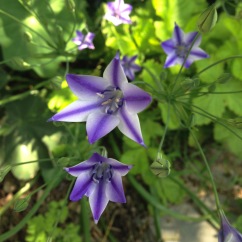Originally published in East Bay Life newspapers February 28, 2018. — I sort of forgot about posting this one and wouldn’t bother now except it looks like Farch might just turn into Marpril. (I edited it rawther heavily for relevance.)
Back in February everyone I talked to was antsy to dig in the garden as if it was time. It wasn’t. It was too soggy to plant. Too early to divide. Too soon for most of us (without a greenhouse) to start seeds indoors (unless we’re talking sweet peas and cardoon). We knew it but (almost) every year we’re tempted by spring-like thaws; the sweet and sour smell of earth and skunk, birds singing, squirrels cavorting, and witch hazels, hellebores, and fancy pink and black pussy willows blooming.
February/March weather can’t be trusted. Might be in the 60s one day (it was a beauty…) and snowing the next (yup). We might have one major truck-toppling, power-outing gale of a Nor’easter followed by 3 more (yes, indeed). That’s how this season rolls. But we shouldn’t let Farch stop us from gardening.
The days are longer and the sun (when it’s out) is warmer and we’re not the only ones to notice. Houseplants are going through a growth spurt, and they’re hungry. Potting soil has very little nutritional value, particularly if you haven’t repotted in a while. (I haven’t.) You could do that now. (I might.) And you should throw some fertilizer into the watering can before your next rounds. I would use Neptune’s Harvest organic fertilizer if I didn’t mind my house smelling like the beach on a red tide day. I do mind. Instead, from now on every few weeks, my indoor plants will (promises, promises) get a drink spiked with a small scoop of JR Peters Jack’s Classic (20-20-20), which resembles Scott’s Miracle Gro in everything but that company’s affiliation with the evil Monsanto corporation.
If you haven’t completed your winter pruning chores, get to it. I’ve been procrastinating pear tree pruning because I’m on the fence about keeping it. It’s a pretty-ish shape when I prune it right but its crop of pears (when I prune it right) are woody and flavorless. Even the squirrels turn up their noses. I’d cut it down and plant something they and I prefer if I could figure out what that might be.
 I cut my serviceberry (Amelanchier candensis) down a few weeks ago because I knew if I let the buds swell, I’d lose my resolve. It’s a sweet native — a favorite — and was one of the first trees I planted here. But I stuck the poor thing in scant soil in an overly sunny and hot spot along my driveway, and although it grew, it was never robust. Besides myself, I blame drought stress and annual Cedar Apple Rust infections born on spring winds from my infected backyard junipers. Last summer the fruit failed to mature and attract flocks of birds in June, and most of its leaves dropped well before fall. Broke my heart. Now it’s a birdbath.
I cut my serviceberry (Amelanchier candensis) down a few weeks ago because I knew if I let the buds swell, I’d lose my resolve. It’s a sweet native — a favorite — and was one of the first trees I planted here. But I stuck the poor thing in scant soil in an overly sunny and hot spot along my driveway, and although it grew, it was never robust. Besides myself, I blame drought stress and annual Cedar Apple Rust infections born on spring winds from my infected backyard junipers. Last summer the fruit failed to mature and attract flocks of birds in June, and most of its leaves dropped well before fall. Broke my heart. Now it’s a birdbath.
Planning-wise I am as behind schedule as I always am and could use a few more indoor days to catch up with my reading, research, imagining, and planning. I want to make pro/con lists of possible pear-alternative backyard tree choices, and a new plan for my driveway bed to make up for the loss of the amelanchier. I should decide now what perennials and shrubs to evict to make room for all the seed annuals I ordered while hungry for summer. I also need to make a propagation plan for said seeds and room for them in the plantry. Clearly, I’ve got some serious gardening to do. So, come on, Farch, lay it on me. One more snow day should do the trick. She said back in February, not ever imagining March could be QUITE such a bitch. Did I follow through on all these intentions? Nope. I think I still might have some time though.
Did you get any gardening done in Farch? Is it spring yet wherever you are?









